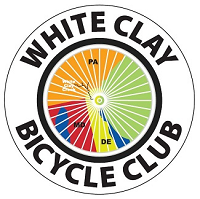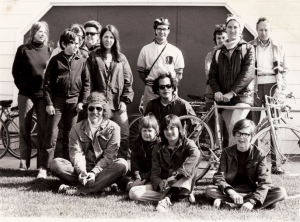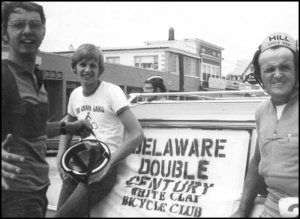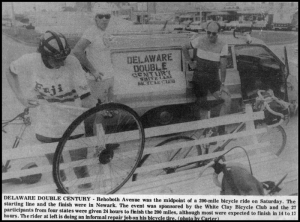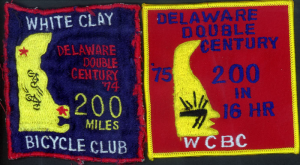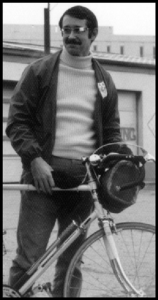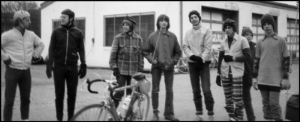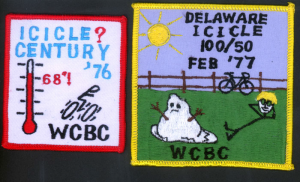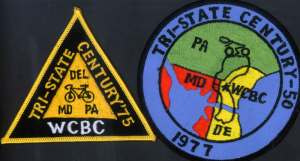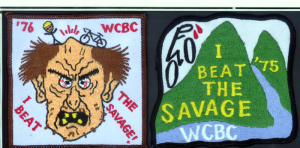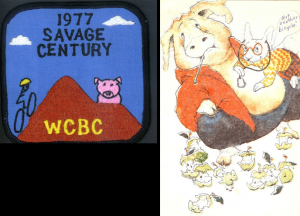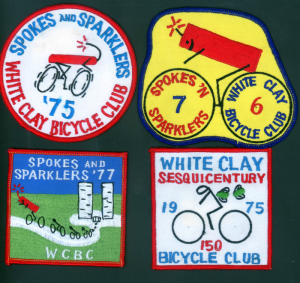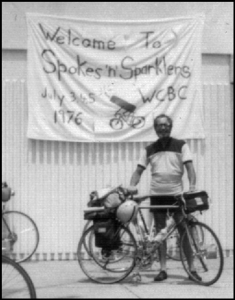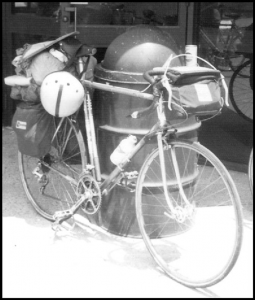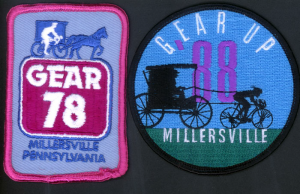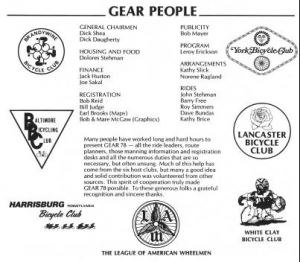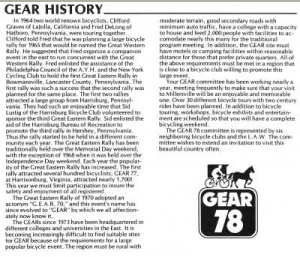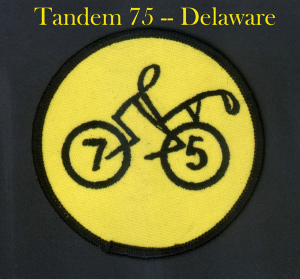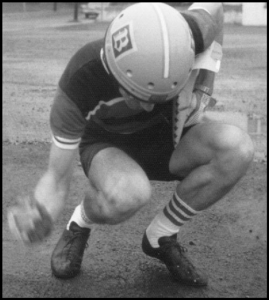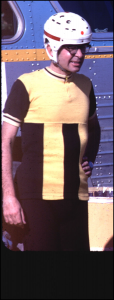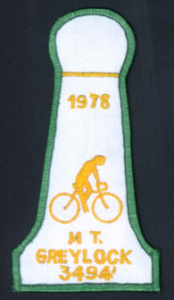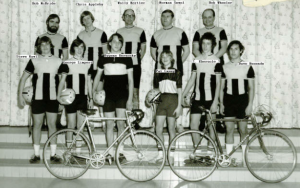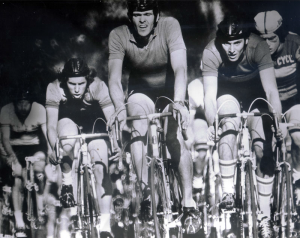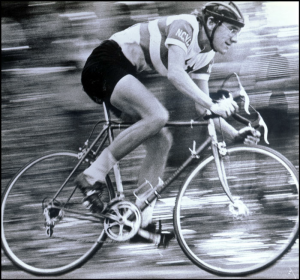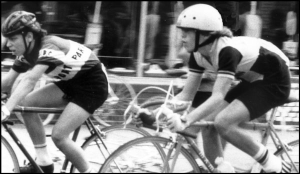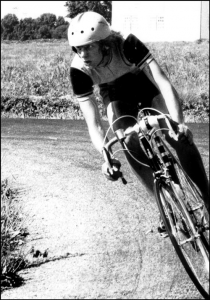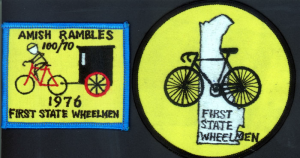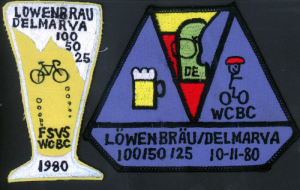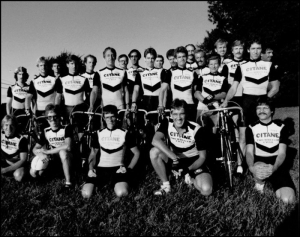Early History of the Club
By Wally Hertler
The White Clay Bicycle Club began in December 1972 by Joel Tabor and John David Lambert, owner of Dependence Bicycle Shop. Joel put together the first issue of Tailwind in March 1973 after bargaining with a Newark printer for a below market price for printing the fledgling newsletter – a price that was honored for several years. Also instrumental in organizing the new club was Ron Harayda. Not long thereafter in June 1974 Joel moved out of the area, and Rod Brice became the driving force of the Club as well as editor of Tailwind. Rod was quite remarkable. He was a Captain in the U.S. Army serving in Vietnam. Upon his discharge in California, he bought a bicycle and rode it across America to Newark, Delaware where his parents resided. Rod’s zest for taking on challenges inspired those of us who were fortunate enough to have known him to do the same. So, the first years of the club were filled with audacious achievements – achievements that most of us never dreamed we could be capable of before we joined WCBC.
During the first couple of years, all WCBC rides started in a small parking lot on New London Road across the street from Dependence Bicycle Shop, which was near a record shop called Wonderland. Hence, the starting place for rides was identified as “Wonderland”. That parking lot subsequently became incorporated into the U of D’s Hollingsworth Lot. I first learned of the existence of WCBC from Bob Wheeler during a meeting of the Delaware Friends of Bikecology – a mostly bicycle-advocacy organization that also scheduled some rides. The first WCBC ride that I showed up for also turned out to be the first WCBC ride for Dave Bundas and Nancy Cooke (now Nancy Purcell). The ride leader was Ken Poole of the Newark Department of Parks and Recreation. All three of us fell in love with the club on this weird ride that took us across a farm field because the ride leader made a wrong turn. Ken Poole also was instrumental in obtaining a facility for the club to hold its monthly meetings – an unheated building belonging to the Newark Department of Parks and Recreation located on New London Road across from the U of D North Campus. Later the club meetings were moved to Maclary Elementary School in Chapel Hill.
Very early photo of WCBC riders with Rod Brice (leather “helmet” standing in center), Ron Harayda sitting on left, Joel Tabor sitting center with sun glasses. Note the young riders.
The first years of WCBC’s existence were a time of great excitement for the members of the new club. The club began to develop ideals and activities some of which remain today. In 1973 Rod Brice introduced us to a series of rides called Spinning Sprockets that was designed to prepare us to ride a double century by the end of the season. A Spinning Sprockets ride was held on alternate weekends with the length of each ride increasing by about 25 miles above the preceding ride. The first ride was 55-miles in length and rather hilly. As the distances climbed above 100 miles, the routes mostly led south of the C & D Canal where it was flatter. The grand finale of the Spinning Sprockets Series – a 200+ mile round trip ride to Rehoboth Beach – was held in October 1973. Unfortunately, it ended prematurely on the return leg a few miles from the turnaround in Rehoboth when wheels touched and several riders went down (I suffered a broken collarbone and dislocated shoulder, both of which were attended to at Beebe Hospital in Lewes). Undaunted by the mishap on the Spinning Sprockets 200-mile ride, WCBC hosted the invitational Delaware Double Century to Rehoboth in June 1974. This event, the first WCBC invitational ride, was successful and brought lots of attention to the club. For many years following the 1974 debut, the June Delaware Double Century was continued using pretty much the same route. Dick Daugherty, one of the club’s earliest members, was also Dean of the Engineering School at U of D, and he was able to obtain permission from the University to use the Hollingsworth Parking Lot for the start of this and other WCBC invitational rides. Later Ed Pellicciaro of the U of D Math Department became a U of D contact. The Spinning Sprockets series of increasingly challenging rides led to a great sense of cohesiveness and pride of accomplishment among the participants and a sense that the club could accomplish almost anything it put its collective mind to. In 1974 a re-run of the Spinning Sprockets series was attempted, but it fizzled.
The 1974 Delaware Double Century – WCBC’s first invitational Ride (L-R: Dave Bundas, Chris Appleby, Rod Brice, Jim Eads)
Newspaper clipping of Double Century (Bob Wheeler by sag wagon door)
Patches for the first two Delaware Double Centuries in 1974 and 1975
As early as 1973 Bob Wheeler organized two WCBC overnight weekend rides. The first was a ride to the Robert Morris Inn in Oxford, MD that took us past the Wye Oak. The second was a twin century to Rehoboth where we stayed at a lodge owned by the Francis Ann Motel, which was located on Rehoboth Avenue between Pirates Cove Motel and DE 1. The twin century to Rehoboth has been held every year since 1973. In 1974 I began several years of organizing the twin century to Rehoboth. In 1974 we stayed in the Francis Ann Motel main unit. In 1975 we stayed at the Shirl Ann Motel on the boardwalk. In 1976 we stayed at the Oceanus Motel which had a swimming pool. In 1977 neither the Shirl Ann nor the Oceanus would have us back, so we stayed again at the Francis Ann Motel. Beginning in 1978 until the present we have stayed at the Pirates Cove Motel for the Rehoboth twin century (that’s 31 years!). The Twin Century to Rehoboth is the club’s oldest continuous event. For several years patches were awarded to twin century participants. The patches often commemorated events or conditions on a particular ride.
WCBC membership climbed from 2 to 35 during the first five months. In 1974 there were 87 members. Membership shot up to 350 in 1975 as a result of free memberships being offered to purchasers of MSR bicycle helmets. In 1976 membership declined to 100, but grew gradually from there. As early as 1973 many women seemed to be attracted to the club. An important attraction for these women was John David Lambert, who was quite good-looking. His well attended Sunday rides were often referred to as “John David and his women”. One of the early members of WCBC was Jack Huston, who, impressed with WCBC’s initial success, started his own bike club in Chester County, the Brandywine Bicycle Club. Thus, the Brandywine Bicycle Club can be considered an offspring of WCBC.
Jack Huston, founder of sister club, Brandywine Bicycle Club
WCBC attracted quite a number of teenagers and University of Delaware students who actively participated in club rides and races (more about racing later). In that respect there seems to be a big difference between the early club and the present, where I have seen few teenagers participating, although that may reflect a distorted perspective on my part. In the early years the more challenging rides nearly always had young participants. Rod Brice convinced several of the early members that they would be able to complete what is probably the most difficult two-day ride in the east, the Baltimore Bicycling Club’s Skyline Drive Tour, in September 1973. This is a ride of 105 miles with 10,000 feet of climbing from Front Royal, VA along the Skyline Drive to Waynesboro, VA on a September Saturday, reversing the route on Sunday. A group of us drove to Front Royal and successfully completed the tour. Every year thereafter for many years we repeated the Skyline Drive Tour, but on several occasions we rode our bikes to Front Royal for the event. In 1974 Rod inspired several of us to try the Great 100 in Wilkes-Barre, PA billed as the hilliest century in the east. We enjoyed the ride enough to return to it for several years, riding our bikes the 126 miles to Wilkes-Barre on Saturday, riding the Great 100 on Sunday, and riding home on Monday.
Riders assembled at start of 1974 Baltimore B.C. Skyline Drive Tour Twin Century (Rod Brice, Dave Bundas and Nancy Cooke at far left)
During the winter of 1973-74 Rod Brice led a 100-mile club ride that he dubbed an “Icicle Century”. Then for 1975 WCBC scheduled an nvitational Icicle Century on Saturday, February 1. The weather was not cooperative. In Newark it was cold, and participants arriving from Harrisburg reported that there was freezing rain to the west. But, the ride went on nevertheless. The route went west toward Colora, MD, looped back toward Newark, and then followed a second loop south of the C&D Canal. As we headed west we found the freezing rain was coating the roads with ice making descents very scary. With the temperature below freezing, ice began to form on the bikes including the gear clusters. This caused many of the riders to be limited to a single gear. I kept shifting through the cogs in order to prevent ice from forming on them. After the food stop (a station wagon manned by Bob Appleby parked along the road south of US 40), I headed across the canal unsure of whether anyone else would do so. Rod headed home to change into dry clothes before crossing the canal for the southern loop. Fortunately the rain stopped, but it remained cold. Because of the time lost in going home to change clothes, it was after dark when Rod was finishing the ride northbound on DE 72. He was not using a light, and he was struck by a car and killed – a tragic loss for all who knew him. In succeeding years WCBC continued to hold the Icicle Century, and as late as 1977 it was still held in February and was still 100 miles in length. In later years it was moved to late March and shortened to a metric Century.
Winter 1974 at the start of club “Icicle Century” ride
Some patches from WCBC invitational Icicle Century Events
Rod Brice married Cathy Fagley not long before his untimely death during the first Icicle Century. During a club ride in 1973 Rod, realizing that, as a new husband he would have to shed some of his club responsibilities, drifted back along the line of riders and asked Dave Bundas if he would be willing to run for WCBC President. Dave agreed, and subsequently headed the club from October 1973 to November 1978. Then Rod drifted further back in the line of riders and asked me if I would run for Vice President, to which I agreed. I also became Tailwind Editor until 1985. In those days the newsletter was typed on an IBM Selectric typewriter (corrections made using white-out), then literally cut and pasted, and taken to the printer. It was also the job of the Editor to pick up Tailwind from the printer and distribute it to bike shops, sell advertising to bike shops, and collect advertising revenue. A complete table of WCBC officers and Tailwind editors can be found in Appendix 5.
The energy of the new club in instituting new invitational rides is quite remarkable. Following the success of the 1974 Delaware Double Century, 1975 saw the first WCBC Tri-State Century (a full century, not a metric), which followed a hilly route through Delaware, Maryland and Pennsylvania. This ride was repeated for several years before being abandoned.
The first WCBC Tri-State Century was held in 1975
In the fall of 1975 WCBC held the first Savage Century, which displaced the Great 100 as the “toughest century in the east”. The idea for the Savage came to Dave Bundas and me as we were riding some of the roads along the Susquehanna River in Lancaster County at the suggestion of Dick Jones. We were so impressed with the steepness and length of some of the climbs that we thought “why don’t we hold an invitational century in this area and call it the Savage Century?” Our original route had most of the climbs that are in the present day route, but in the reverse direction, so that some of the worst climbs came later in the ride.
The Savage Century made its debut in 1975 and continues to be popular
One of my most memorable experiences in the Savage Century occurred in 1977. As I was leading a group down a hill on a rural road in the Oxford area enroute to the major climbs along the Susquehanna River, a large dog came onto the road ahead of us. So we shouted at the dog and made noises to scare him off the road. This worked, and the dog retreated. But, three small pigs, mistaking the shouts as pig-calls, ran onto the road from the left. I hit the first pig and fell. Eric Conrad hit the second pig and also fell. The third pig made it across the road safely. Eric was unable to continue riding. But I just suffered some road rash and continued on. But the chest is comfort while climbing indicated that I had cracked a rib.
The 1977 Savage Century patch commemorates the pig incident. Get well card from Maryann and Roger Raspen
A month later, while participating in a club ride led by Joe Masterson through Elk Neck State Park to Turkey Point on Chesapeake Bay, Dick Shea and I raced ahead of the group of riders over the short rolling hills when a large doe came onto the road ahead of us. She began running away from us on the narrow road, but I nailed her, dropped to the ground while my bike (a titanium Teledyne Titan) continued into the woods and jammed between two trees. Dick rode over me and was launched over the handlebars, cracking his MSR helmet which cut his ear. I suffered a broken collar bone (the same one as in the 1973 double century crash) and several cracked ribs. At Union Hospital in Elkton Dick’s ear was stitched and his entire head wrapped in beige bandages so that he looked rather like a medieval monk. Although his appearance was laughable, it hurt me so much to laugh (cracked ribs) that I had to face away from him during our stay there. Although his appearance was laughable, it hurt me so much to laugh (cracked ribs) that I had to face away from him during our stay there.
Another kind of invitational event that was becoming popular by the 1970’s was the bike rally, in which a host organization arranged for articipants to stay multiple nights usually in a college dormitory with a schedule of rides, workshops, and other activities. Beginning in the 1960’s the League of American Wheelmen (LAW, now renamed the League of American Bicyclists, LAB) held rallies in the northeast U.S. called Great Eastern Rallies, or GEAR. My first century ride was during a GEAR held at Hood College in Frederick, MD in early 1973.
If the LAW could organize GEARs, why couldn’t WCBC organize a rally at the University of Delaware? Well, we could, and we did. The rally was held at the U of D North Campus over the July Fourth weekend 1975 and was called Spokes and Sparklers. The event was repeated in 1976 and again in 1977. About 125 bicyclists attended these rallies. And, in the White Clay tradition, some of ther ides at Spokes and Sparklers were quite challenging. There was a 150-mile ride – a Sesquicentury – that headed south across the canal. And there was a hilly time trial route called the Whiskey Hill Time Trial. A time trial participant would go to the reception desk at North Campus and record the time, run outside to their bike and take off on the painted route, which took them up Indiantown Road (also known as Whiskey Hill) and back to campus where they would run back in to the reception desk and record their finishing time.
Patches for the three years of WCBC’s Spokes and Sparklers Rallies held at the University of Delaware North Campus. A 150-mile ride was featured.
Spokes and Sparklers Rally at U of D North Campus – Bill Schneider rode to the event from California.
Bill Schneider’s bike at Spokes and Sparklers
In 1978 WCBC agreed to co-host a GEAR Rally at Millersville University with five other bike clubs. White Clay’s Dick Shea and Dick Daugherty were chosen to be General Co-Chairmen of the Event. The attendance at GEAR ’78, at 2400, was the highest attendance for any LAW rally up to that time. In 1988 WCBC again co-hosted a GEAR at Millersville University along with Lancaster Bicycle Club and Brandywine Bicycle Club. I was editor of the program book for GEAR ’88. Note the scruffy helmeted rider in the GEAR ’78 program book page below that became the WCBC logo on Tailwinds for many years. He was drawn for the Club by Gary Schmitt.
WCBC co-hosted League of American Bicyclist GEAR Rallies in 1978 and again in 1988 at Millersville University. WCBC’s Dick Shea was General Chairman in 1978.
A flavor of GEAR from the GEAR ’78 Program Book
In 1975 Bob Wheeler with Joe and Lynn Masterson organized a one-day rally for tandems in Newark at the Howard Johnson’s Motel. The event was attended by 40 tandem riders from all along the east coast.
Patch from 1975 tandem rally held in Newark
There were a variety of innovative WCBC club rides in the early years. For example, Brian “Croupier” Hanson led a “Roll the Dice” ride in 1975 in which the roll of the dice determined the route. Like it or not, Brian rolled eleven thus condemning the group to ride the infamous “Hills of Delaware” – a 52-mile route that climbed every major hill in northern New Castle County.
Brian Hanson’s “Roll the Dice Ride”. Destination: The Hills of Delaware (Notice the barely ventilated MSR bicycle helmet)
Joe Masterson was an avid ride leader who loved picnics and campouts. During the cold weather he led Soupçon (pronounced soup’s on) Rides to Blackbird Forest where his wife waited for us with hot soup. He also liked to lead family picnic rides to Beck’s Pond and Lum’s Pond. He called these rides the “du Ponds of Delaware”. On one of his family rides to Beck’s Pond a gentleman showed up for the ride in an old VW Beetle. He rode a three-speed bike and introduced himself as Ernie. After the ride he told Joe how much he had enjoyed the ride, and he mentioned that he had some property along the Brandywine which Joe was welcome to use for a club overnight camping ride. A few months later Joe called the phone number he had been given to get directions to the “property” to pick out a camp site. When he arrived at the property he discovered that it was Granogue, and that Ernie was Irenee duPont, Jr. The club had the camping overnight there, and, despite the rain, a good time was had. The hot spaghetti dinner cooked under a large tent was especially appreciated.
When the club was first formed there was no general availability of protective helmets for bicyclists other than the leather strap “helmets” that were referred to as hairnets. They didn’t really offer any real protection against head injury in a fall. So, many of us used hockey helmets until Mountain Safety Research adapted their mountain-climbing helmet for bicyclists by providing four small holes for ventilation. These helmets were effective but insufficiently ventilated. But, it was not long until Bell Helmets produced a well ventilated helmet that was soon adopted by most of the participants of WCBC rides. In 1975 Bob Wheeler and I prepared a slide show called “Bicycle Safety for Motorists” with a professionally recorded sound track. Copies of the show were requested by the League of American Wheelmen and the Bicycling Federation of Pennsylvania for reproduction and distribution. PennDOT agreed to make the reproductions for Bicycle Club jersey, dubbed the “bumble bee” jersey that was the official club jersey for several years.
The author in 1974 wearing a hockey helmet and a White Clay Bicycle Club jersey, dubbed the “bumble bee” jersey that was the official club jersey for several years.
Beginning in the first year of the Club’s existence overnight weekend tours became popular with members. In 1976 I led a four-day tour to a League of American Wheelmen National Rally in Carlisle, PA. This whetted my appetite for longer tours. So, in August 1977 I led a tour to Brevard, NC by way of Frederick, MD, Front Royal, VA, the Skyline Drive, and most of the Blue Ridge Parkway. With only a small handlebar bag, no windbreaker and a poorly planned 133-mile route to Frederick for the first day this tour was not very well organized. For most of this tour my only companion for the stretch on the Blue Ridge Parkway was long-time WCBC member, Jim Eads (1969 Pennsylvania State Road Champion), who joined me in Waynesboro, VA. The participants for the first portion of the tour were Al MacDonald (who later became active in bike race-promotion and officiated at the Trexlertown Velodrome), Bob McBride (first President of First State Wheelmen – the racing division of WCBC), and Gary Custis (a math grad. Student at U of DE). The following year, 1978, a larger group rode to Massachusetts to participate in the Berkshire Wheelmen’s Mount Greylock Century that featured a climb of the 3494-foot mountain as part of a ride through the Berkshire Hills. Our planned tour for 2010 will again take us over Mt. Greylock and through the Berkshire Hills. Many of the earlier tours took us to League of American Wheelmen (later LAB) GEAR rallies – one as far away as Murphreesboro, TN.
Patch from 1978 Berkshire Wheelmen’s Mount Greylock Century
Bike racing in WCBC began almost as soon as the first club rides. In 1973 Ken Poole, working for the Newark Department of Parks and Recreation, organized road races in Newark neighborhoods, and participation was broad. In 1973 those with a particular interest in racing organized themselves into a racing club named First State Wheelmen (later the name was changed to First State Velo Sport), which became a division of White Clay Bicycle Club. Beginning in 1974 WCBC’s Vice Presidency was shared by a Vice President (Touring) and a Vice President (Racing), the latter serving as head of First State Wheelmen. FSW became affiliated with the Amateur Bicycle League of America (ABL of A, which was superseded by today’s United States Cycling Federation, USCF), which controlled organized bicycle racing in the U.S. The first FSW president was Bob McBride. In 1975 Bob Stephenson’s Newark Schwinn Cyclery became the first sponsor of FSW. Road races and time trials were held on a race course near the C & D Canal using Frazer Road. The course became known as the Frazer Road course. Other courses used for road races were Barksdale/Casho Mill and North Star/Crossan/Doe Run.
Some of the early members of First State Wheelmen
A member of FSW who enjoyed racing but also had the skills needed to promote races was Jim Elliott. In 1974 in collaboration with the Delaware Friends of Bikecology, Jim and FSW promoted the first ABL of A-sanctioned bike race in Delaware, The Tour of Rockford, in Wilmington’s Rockford Park as part of a Delaware Bicycle Festival October 20-27 (see Appendix 6). The Delaware Bicycle Festival was sponsored and promoted by the City of Wilmington, the Delaware Friends of Bikecology, and First State Wheelmen, and featured an entire week of bicycling events (including the popular Great Commuter Race to downtown Wilmington), culminating in the races in Rockford Park. The Festival was repeated in 1975, 1976, 1977 and 1978. Kite-flying became a part of the festivities, and the 1977 Delaware Bicycle Festival was dubbed “Bikes, Kites, and Bluegrass – A day in Rockford Park.” In 1978 Frisbee activities were added.
Senior men’s race in Tour of Rockford
A rider from the National Capital Velo Club in Tour of Rockford
For several years a sanctioned road race was held on the Frazer Road course on the Saturday preceding the National Capital Open races in Washington, DC in the spring. This attracted lots of big name racers, who were able to get in two days of racing on a single weekend. These races, sponsored by a local bike shop chain, were named the Chain Gang Challenge. One of the youngest FSW racers was Pat Casey, who mostly had to train with much older riders. This probably contributed to his many successes.
FSW’s Pat Casey on right – one of the club’s youngest riders
Chris Appleby, a young FSW member, riding a time trial
In 1978 Jim Elliott took over the reins of FSW. He had always dreamed of Delaware Blue Hen Stage Race, on April 22-23, 1978. Delaware Trust agreed to sponsor the stage race. The featured event was a road race from the Delaware Trust branch in Claymont to Midway, just outside Rehoboth Beach. Following the road race on Saturday there would be a Sunday morning time trial followed by a criterium on a circuit in downtown Rehoboth Beach.
In hindsight it was certainly a mistake for the promoters (Jim and I) to be participating in the race. Nevertheless, everything went smoothly as we headed down Philadelphia Pike into Wilmington behind the pace car, which was a Delaware Trust van. The Wilmington Police had the course through the city well protected. But, the pace van made a wrong turn at Front St. taking the riders across multiple rough railroad tracks causing some spills and lost water bottles. We continued south on US 13, and the Juniors joined the procession south of the city at Wilmington Manor since the maximum distance they were permitted to race in a road race was lower than allowed for Seniors. By agreement with our State Police escort, the race participants were to remain in the right lane of US 13, allowing motor vehicle traffic to get past in the left lane. However, a brisk southwest wind caused the peloton to fan out into the left lane, blocking traffic. To move back into the right lane would, for most riders, mean losing contact with the peloton and giving up any chance of finishing with the group. Meanwhile, the Juniors got off course and were moving west toward Maryland. With the massive traffic jam in mind, the governor cancelled the road race as it made its way through Dover. It took the State Police helicopter to stop the indomitable Juniors. The next day the time trial and criterium in Rehoboth went off without a hitch.
In 1979 Delaware Trust was willing to give FSW a second chance to put on a stage race. This event was called the Tour of Northern Delaware. The road race took place in Centreville on Kennett Pike, Owls Nest Road, Old Kennett Road, and Snuff Mill Road with the start-finish line at Delaware Trust’s Centreville branch. This time the road race proceeded without any problems. Some of the views for spectators were spectacular. The next day the hill-climb time trial on Beaver Dam Road, and the criterium in downtown Wilmington likewise went smoothly. Jim Elliott, who did race in the criterium, made a wrong turn and was disqualified.
In 1976, in order to earn some money to bolster their treasury, First State Wheelmen hosted a century (with a 70-mile option) in southern Delaware called the Amish Rambles.
1976 FSW Amish Rambles patch and FSW logo patch
In 1980 FSW and WCBC organized an unusual invitational ride, the Lowenbrau Delmarva Century (100, 50, and 25 miles). The start/finish was in Augustine Beach, and the ride featured, at the finish, a Lowenbrau beer truck that dispensed refreshments to the riders as they finished.
Patches for the Lowenbrau Delmarva Century/Half Century/Quarter Century
First State Wheelmen merged with Delaware Velo Sport to become First State Velo Sport, the racing division of WCBC. Below is an early photo of FSVS members.
Standing (l-r) X, Joe McMillan, Wim Daniels, X, Mark Zebley, Eugene Bernosky, Tom Compton, Guri Singh, X, Chick Trayford, X, Bill Meakin, Bill Speg, John Bare, Christie Hutchison, Tom Hartley, Bob Wooding, Brian Farkas, Mike ? Kneeling, Pat Casey, Eric Conrad, Bryan Patton, Craig Leiser, Ron Frazer.
Following the early years White Clay Bicycle Club continued to expand with the addition of toucans, a tandem division.
